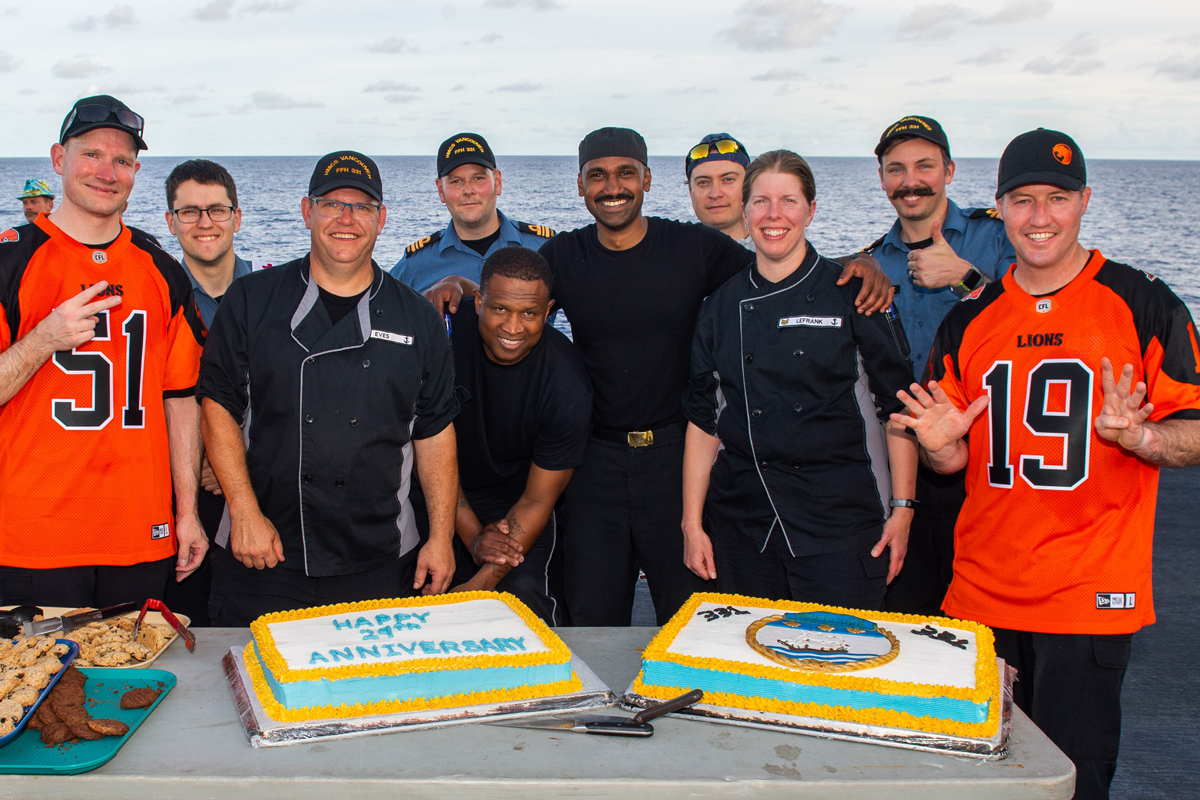The legacy of HMCS Vancouver
By Lookout Production on Sep 02, 2022 with Comments 0

Members of HMCS Vancouver celebrated the 29th VAN-iversary with a BBQ and cake on the flight deck while sailing during Operation Projection. Vancouver will also support Operation Neon as part of their deployment to the Indo-Pacific before their anticipated return to Esquimalt in December. Photo: Sergeant Ghislain Cotton.
Essay by S2 Teagan Villeneuve
—
The legacy of HMCS Vancouver extends over a century, with three iterations of the ship, each serving a particular purpose with success.
The first commissioned ship to bear the name HMCS Vancouver was an S-class destroyer F6A, built in 1917. It was formerly known as Her Majesty’s Ship (HMS) Toreador of the Royal Navy and was given to Canada on loan. On Mar. 1, 1928, the Royal Canadian Navy (RCN) officially commissioned the ship as a training vessel.
The first iteration of HMCS Vancouver successfully contributed to the modern Canadian Navy by fostering experienced sailors. Three 102mm guns decorated the ship’s upper decks and 450mm and 533mm torpedo tubes. It was equipped with a 40mm pom-pom for anti-air and other minor threats, along with four Lewis machine guns. Sailing at a top speed of 30 knots, the first 20th century HMCS Vancouver was considerably faster than other destroyers because of its build and materials. That HMCS Vancouver took part in the most extended RCN cruise attempted in 1934 for a training deployment to the Caribbean Sea. However, by 1935 the destroyer had deteriorated and was eventually scrapped as it would not be able to sail back to the United Kingdom for refit. It was decommissioned on Nov. 25, 1936.
The second iteration of HMCS Vancouver was commissioned during the Second World War, and contributed to the many freedoms Canadians enjoy today. It was a Flower-class corvette, commissioned on March 20, 1942, and built for an escort capacity, with a top speed of 16.5 knots and a crew of 67 people. The armament on board was catered to reacting to a small surface, air, and subsurface threats. The ship was equipped with one four-inch gun and one two-pounder pom-pom, just like its predecessor. Although it did not include torpedoes, it had depth charges that were thrown and launched using rails on the upper decks. It also had more advanced radar systems and sonar systems.
Notably, in August 1942, HMCS Vancouver was assigned to the Aleutian Islands Campaign in the Pacific and, in February 1944, to the East Coast to help with escorting operations in the Atlantic. Following those, HMCS Vancouver was an escort for convoys between Quebec and Labrador. The second iteration of HMCS Vancouver was decommissioned on June 26, 1945.
A third ship, Halifax Class frigate FFH 331 HMCS Vancouver was commissioned on Aug 23, 1993. With a displacement of over 4,000 tonnes and approximately 240 crew, this ship’s capabilities are the most advanced of its predecessors. Equipped with modern radars, sonar acoustic sensors, and armament, HMCS Vancouver is operationally flexible and can be deployed anywhere in the world to complete any given mission. With the addition of the flight deck, the ship can embark on a helicopter and an air detachment. Still serving to this day, HMCS Vancouver has been on many operations and exercises, contributing to Canadian presence abroad.
Using the same ship’s badge, the traditions and spirit of the first two iterations are carried on. Modern training and procedures allow the ship’s company to complete tasks at the highest level, contributing to the legacy of previous iterations. Out of all three ships of the same name, FFH 331 has been commissioned the longest.
HMCS Vancouver’s legacy continues to strengthen today and will be ready for what challenges the future may bring.
Filed Under: Top Stories
About the Author:





